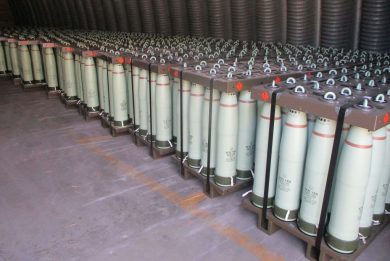EuroPULS: a multiple rocket launcher with munitions à la carte
At the Future Artillery Conference, organised by Defence iQ in Paris, rocket launchers were starring, as many presentations from different armies were showing how these systems are becoming one of the key elements to provide long fires to their artillery formations. At DSEI 2023 KNDS and Elbit Systems signed a teaming agreement for the development of the EuroPULS future rocket artillery system, the Paris event being the right place to get an update on this system, prior to Eurosatory
Work on the EuroPULS started in 2022, ahead of the signing of the agreement at the London exhibition. The document formalized and implemented the strategic cooperation between the two companies, which combines the capabilities from KNDS as a systems house with those of the technology group Elbit Systems.
Until now multiple launch rocket systems (MLRS) were developed for proprietary ammunition, however the war in Ukraine shows how much flexibility is a key issue, allowing not only to adapt to the mission but also to cope with possible shortage of original munitions. Hence the idea to develop a modularly scalable and flexible system that can be integrated to fire from any mobility platform with pinpoint accuracy and safety missiles coming from any provider.
The teaming sees Elbit providing the rocket launcher derived from the company PULS™ (Precise & Universal Launching System), while KNDS Deutschland acts as system integrator. Beside mechanical interfaces to accept rockets and missiles of different origins, the key element is the fire control system (FCS) which is based on that developed by Elbit Systems, with inputs from that of the RCH155 wheeled self-propelled howitzer by KNDS; the aim was to develop an FCS capable to easily integrate new ammunition while respecting European safety and security standards. The modular FCS is ITAR-free and can be linked to any fire direction centre.
The system features two launcher pods, which can be loaded with different types of ammunition giving full flexibility even at single-launcher level. The number of ammunitions depends on their type, as these can go from the new training rocket developed by Elbit Systems and Diehl, exhibited at the Defence iQ conference in Paris, which has a range of 15 km, to guided missiles with over 500 km range.
The munitions proposed for the EuroPULS obviously contain those from the original PULS system such as Elbit Systems’ Accular 122 and 160 mm guided rockets, with respectively a 35 km and 40 km range, Elbit/Diehl Extra long-range high-precision rocket that can reach 150 km, Elbit Predator Hawk Long-range rocket for in-depth precision strikes that can reach targets at 300 km, all those having a declared CEP of less than 10 metres. The EuroPULS is also capable to fire Elbit’s SkyStriker loitering munition, which can reach its objective at 100 km distance; provided with two different warheads, with respective mass of 5 or 10 kg, it can loiter for up to 2 hours with the smaller one and 1 hour with the bigger one. At the Future Artillery Conference Saab was proposing its Ground Launched Small Diameter Bomb (GLSDB), this 150 km range ordnance being also among the EuroPULS effectors basket. The new MLRS will also accept Kongsberg Naval Strike Missile (NSM), capable to hit land and sea targets at over 250 km range. Looking at even longer ranges, short of 500 km, two systems are proposed. MBDA is developing its JFSM (Joint Fire Support Missile), compatible with the in service MARS (the German name for the US MLRS), while the same MBDA together with Kongsberg and Diehl launched the development of the 3SM Tyrfing (Super Sonic Strike Missile), both missiles having a 500 km range. As we can see no US MLRS-related ammunition are part of the system missile portfolio; EDR On-Line understood that technically these are compatible, however legal issues prevent these munitions to be used on the EuroPULS, at least for the time being. How much similar issues might impact the GLSDB, a derivative of Boeing’s GBU-39 Small Diameter Bomb, is to be seen.
The system proposed to the Bundeswehr by KNDS is based on an Iveco Trakker GTF3 8×8 chassis, fitted with a protected cabin. Powered by an Iveco Cursor 13 six-cylinder turbocharged engine providing 500 hp ensuring a 90 km/h speed and a range of over 750 km on road. The cabin hosts three soldiers, protection level depending on customer’s choice, the windshield being protected by metal shutters during firing, to avoid abrasive jet blast to damage armoured glass. Behind the cabin a crane allows the EuroPULS to autonomously reload its pods; this means that resupply trucks will leave the pods with required ammunition at a rendez-vous point where the launcher will head once it finished the firing mission, ensuring maximum dispersion thus reducing the risk of concentrating a load of ammo at the same place. Should a customer select a truck unable to also carry a crane, for example a 6×6 chassis, reloading will need the assistance of a loading truck fitted with the crane. In the German configuration the EuroPULS will have a combat mass of 33.5 tonnes, dimensions being 10.5×2.55×3.83 metres, height being dictated by the crane. The height might be even higher should the customer decide to install a remotely controlled weapon station on the cabin, the roof being designed to withstand the mass and recoil forces of an RCWS armed with a machine gun.
The EuroPULS flexibility is not linked only to ammunition. The system can be integrated on different wheeled and tracked chassis. The Netherlands ordered its PULS launchers installed on Scania Gryphu 8×8 trucks, another option being Rheinmetall HX trucks or Tatra 6×6 chassis, a BAE Systems tracked platform being also a possibility.
EDR On-Line understood that KNDS is currently building the prototype of the EuroPULS in the German configuration, which should be ready in Q3 2024 to start firings before year end. According to the company, depending on orders the EuroPULS should be available by 2027.
Photos by P. Valpolini






